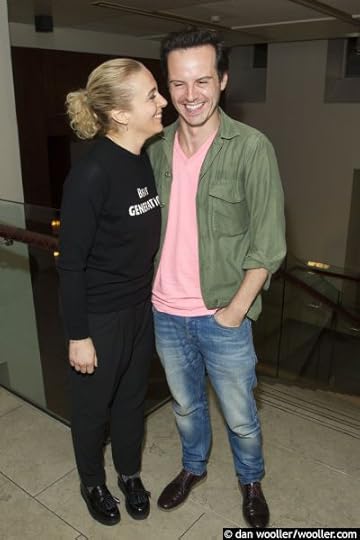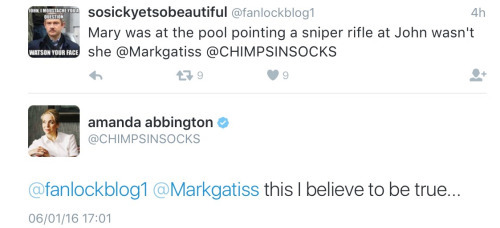XistentialAngst's Blog, page 200
January 7, 2016
John claims the mantle of storyteller
Another piece of evidence for the TAB as pivot point for the Johnlock arc:
In TRF, Jim both tells a story and calls himself “the storyteller”.
In TAB:
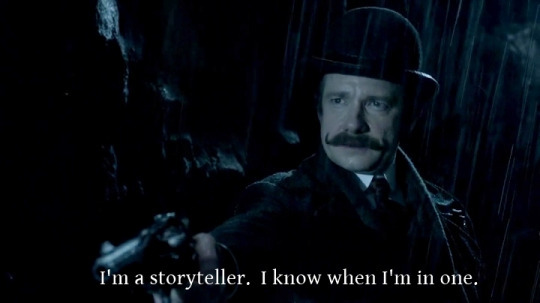
Which, of course, is Sherlock’s metaphor for allowing John (his desire for life and just, desire) to take over the narrative from Jim (his self-loathing and fear).
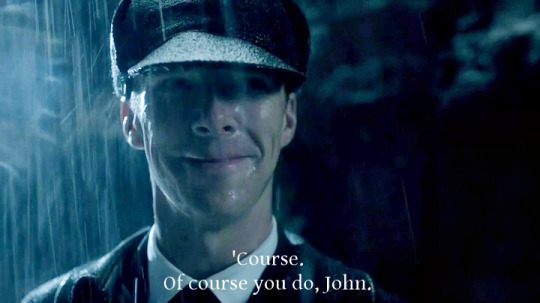
Edited to add: Sherlock making the decision to look at himself with love rather than loathing, trust himself rather than struggle against who he is - by accepting John as his inner narrator rather than Jim.
(This story is better than years of therapy.)
(Also, if you can look at the second screen capture and call Sherlock a sociopath who is not madly in love with John, well, I am afraid we are going to have to part ways, friend.)
YES Rose! Yesssssss!
I love this theory.
tptb: they didn't like the corpse whipping in the pilot because they thought it meant he was gay
asip: sherlock still beats the corpse w a riding crop briefly
tab: sherlock beats the corpse for an uncomfortably long time, significantly harder, with a cane
tillieke:
Conductor of light - Sherlock by tillieke
I did this...
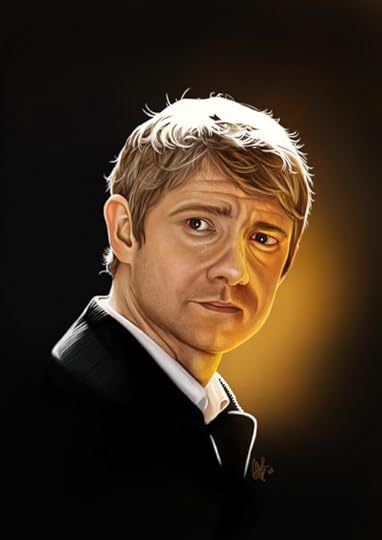
Conductor of light - Sherlock by tillieke
I did this one several months ago to be auctioned for DashCon. I have no clue who won it though. So if it’s you and you want me to take it down again just give me a shout :)
Pretty!
He’s Always Like That. He’s Always Been Like That.
So, this is a pretty facile observation, but I haven’t seen it laid out anywhere else, so I’m going to put it down here.
In the retelling of John and Sherlock’s (or Holmes and Watson’s) first meeting in TAB, Stamford’s Victorian introduction is not significantly different from the one he gives in the modern timeline of the show. The two moments are shown within only moments of each other in the special, with the modern first meeting shown in the “Previously on Sherlock” callback before the Victorian MP stuff properly begins.
The interactions mirror each other so closely (except for instead of John giving Sherlock his heart, Sherlock gives John his dick??? I don’t know…) that the little differences that aren’t mandated by historical accuracy bear particular scrutiny. There’s one moment in particular that stuck out to me as I was rewatching it just now, and though it’s not as earth-shattering as some of the other meta that you truly ridiculous geniuses are coming up with, it’s a nice little reinforcement of what has kind of been established is the writers’ mission statement and the driving argument behind TJLC.
Modern Meeting:Sherlock (To John): The name’s Sherlock Holmes, and the address is two-two-one-bee, Baker Street. (To Mike) Afternoon.
Mike (To John): Yeah. He’s always like that.
Victorian Meeting:Holmes (To Watson): The name is Sherlock Holmes, and the address is two hundred and twenty one bee, Baker Street.
Stamford (To Watson): Yes. He’s always been like that.
The tiny little difference in the phrasing of this interaction, which I have watched in its modern iteration upwards of eleventy kabillion times, definitely twigged something as I was watching TAB the first time. It certainly doesn’t take much to connect the dots, though, once you put the two scenes together and consider their context.
We’re inside Sherlock’s Mind Palace, and he’s just been reading about his first meeting with John Watson on his phone (textually stated in ASiB to be a representation of the heart). We’re about to watch the gayest 90 minutes of television ever committed to film, and yet somehow the general population will still be able to believe that John and Sherlock are just bros, just as they have been able to for 130 years.
Heteronormative assumptions will stubbornly preclude any reading of Holmes and Watson as lovers for a whole big swath of the viewership, even when their actions are most easily explained by romantic feelings between them. When Johnlock finally becomes canon, it’s going to be a game-changer for the way these characters are read in all previous and all subsequent adaptations of their story. They will finally be out, and it will be impossible to shut them back in the closet again. Why is that?
Because the writers are playing the long game, and their entire argument is laid out by Stamford when he facilitates the first meeting between the most famous and culturally-pervasive queer couple in the world.
Sherlock Holmes is gay. He’s always like that. He’s always been like that.
And not only in the BBC version written by a gay dude and his friend the plot-twist guy. Always. He was gay in the original ACD stories, and he’s gay now, and he has been in love with John Watson in every permutation of their story ever set to page or screen.
Not revolutionary, by any stretch of this fandom’s considerable deductive skills, but maybe a nice little clip for the news shows to use when Mofftiss finally blow the doors off this big gay circus.
I love this so much!
crylock:
johnlocktm:
when Mary isn’t even part of the cult of righteous women because she’s not...
when Mary isn’t even part of the cult of righteous women because she’s not righteous at all :^)
this was such an explicit decision tho like going off of everything in the episode (Mary first appearing wearing a black “wedding dress,” Mary being a suffragette, Mary being disregarded by John, Mary’s secretive comings and goings without John’s knowledge) Mary had everything in place to be part of the cult of women who are “supposed to win,” yet she wasn’t part of them…..hm…..really makes u think doesn’t it……
Exactly! Here’s my take on it from my meta on Mary and Birdy Edwards:
But Mary wasn’t a ‘bride’ in TAB. She wasn’t part of the conspiracy.
Yeah, no, she wasn’t explicitly in the cult. Which, on first viewing, made little sense to me. But look, they’re saving her for bigger things in S4. Why would they want to waste her lovely evilness as a throwaway moment in TAB? The very fact that she wasn’t SHOWN as part of the cult of women–when Molly, Janine, and even Mary’s MAID were there, is a bit weird, isn’t it? I mean, who hired the fucking maid anyway? So clearly, Mary is somehow involved with the cult yet she stays aloof and ‘hidden’ in that cult-reveal scene.
Also, Mary is supposedly working for Mycroft in TAB, yet she just figured out about the cult right before she meets Sherlock and John in the crypt. Really? She just figured it out? when she’s a) set up as one of the smartest women in London so if there is an underground feminist thing she’d be part of it and b) her own (otherwise useless) maid is in the cult? Yeah, no, that doesn’t really work. Clearly Mary does know about the cult and she is lying in this scene. Which makes her more suspicious than the women who are actually outted.
She would have been LESS villainous if she’d been openly in the cult. After all, they weren’t bad people really, just oppressed. That would have made more sense with her put-open-and-ignored-wife guise in TAB. But no.
johnwatsugh:
when ur evil twin plans are going swimmingly
lol
watsonshoneybee:
John: “I’m a storyteller, I know when I’m in one.”
Sherlock: “Of course…of course...
John: “I’m a storyteller, I know when I’m in one.”
Sherlock: “Of course…of course you do, John.”
In reality, John is also caught in a ‘story:’ the fiction of his reconciled marriage to Mary and the fiction of Mary’s identity. Sherlock is realizing that John knows that this fiction is false; John knows that he cannot go back to the fiction that existed prior to Mary shooting Sherlock because it wasn’t real.
Throughout TAB we see Sherlock trying to reconcile Mary’s identity with John’s apparent choice to forgive her; he goes to lengths to imagine a worthy cause for her (women’s suffrage) because in reality she doesn’t have one. He imagines her aligned with Mycroft, but can’t help but code her as untrustworthy by imagining her taking Mycroft’s bribes to spy on Sherlock. He imagines her as deceiving John and ignoring John, while John barely notices her undercover life as though he doesn’t care. But then we come to the waterfall, and John tells Sherlock that he needs to go back to reality, and John also tells Sherlock (read: Sherlock tells himself that John has this knowledge) that John knows what is and isn’t real.
Sherlock realizes that not only is he better with John, stronger with John (made stronger by sentiment), he finally realizes that John’s forgiveness of Mary wasn’t genuine. John isn’t abandoning him, he’s living in a story world right now–to protect Sherlock, to protect himself, to protect the baby–but John is coming back to him. That’s when Sherlock really decides to wake up. It’s not just that there’s always two of them: it’s that there’s only the two of them.
Nice observation.
January 6, 2016
Just read your graveyard domestic... Question for you. Few friends and I are starting to wonder if he whole bloody episode is actually ALL MP. from start to finish. Thoughts?
Oy. This is a question that is still hotly being debated, and there’s no one accepted answer out there. People arguing different ideas each have at least some data to back up their arguments. Honestly, I think this will be one of those things we’ll continue to quibble over until we get series 4.
Here’s what I can tell you. From what I can see, there’s a general consensus that the graveyard scene and the hospital scene are mind palace. There are some people who think the first plane scene is real but not the last; or the last plane scene is real but not the first; or that what we see fades between mind palace and reality fluidly among both scenes; or, like you, that the whole damn thing is in his head. So no matter what you’re thinking, there’s a reading of that.
For my two cents, my gut feeling is that both plane scenes are real. (But I’m open to hearing different readings and getting more data, of course.) Here’s why:
1) the physical anomalies that would indicate mind palace on the plane don’t convince me (yet). Mary looks pregnant to me. Sherlock hands Mycroft a list, and the same list shows up in Mycroft’s hands again at the end. The hospital scene and the graveyard scene were clearly not real, as evidenced by the sudden location shift, and you know, the skeleton suddenly animating itself and attacking Benedict Cumberbatch.
2) The characterizations that people are saying are different could just as easily be season 4 foreshadowing as it could be an inconsistency indicating mind palace. As a reminder, we don’t know what the hell Mary or Mycroft have been up to since she shot Sherlock. We don’t know what they know about each other, if they’ve worked something out behind the scenes, or what. Mary doing the phone hacking thing could just as easily be a hint of her as Moriarty as it could be mind palace. Then, there’s Mycroft. People are saying that a blatantly emotional Mycroft is out of character, but consider this: Sherlock’s perception of Mycroft is as the nagging, overbearing, big brother. We see it in reality (think ASIB), and we see it in his mindpalace (the fatcroft scene, and HLV). However, Mycroft in reality is somewhat gentler with his brother. Remember the phone call to mycroft in TSOT? He isn’t all that antagonistic. Mycroft’s reaction on the plane strikes me more as character development than anything else.
3) Think about the script as if you were one of the writers. This is what really settles it for me, but it is based outside of the episode itself, so bear with me. The whole “it was all in his head” trope is one that needs to be used very sparingly, and very judiciously, because if you fuck it up it can easily become a cliche or a crutch on which to hang bad writing, and generally a cheap trick which runs the risk of truly pissing off your viewing audience if you go astray. Basically, I think the writers have spent the available collateral they have on this one. Most viewers aren’t going to assume the plane scenes were fake. So for them to come back in 4.1 and basically say, “ha ha the modern bits were actually fake! Tricked you again!” simply would not fly for the vast majority of the audience. I think they’re more sophisticated writers than that. This is less of an argument and more of a gut feeling, but there we go.
Of course, on the other hand………..there is tie hell, which is very, very real. (Thanks so fucking much for that, @skulls-and-tea) Basically, who fucking knows. Not me.
loudest-subtext-in-television:
bug-catcher-in-viridian-forest:
loudest-subtext-in-television:
what...
loudest-subtext-in-television:
bug-catcher-in-viridian-forest:
loudest-subtext-in-television:
what do non-Johnlockers tell themselves about “I’m there if you want it”
If you make them notice they actually tell you that you shouldn’t pay so much attention to the dialogue.
I like that. The best way to analyze a TV show is to ignore it. It’s so pure and simple. None of that complicated stuff.
What even is “dialogue” anyway, you know? Characters say things sometimes, but nobody knows why it happens. We could ask ourselves these things all day, but what would be the point?
lol,lsit. Oh the shade!
miadifferent:
constancecream:
constancecream:
[x]
What a...
XistentialAngst's Blog
- XistentialAngst's profile
- 15 followers




